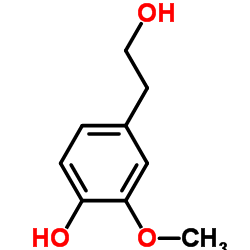Homovanillyl alcohol

Homovanillyl alcohol structure
|
Common Name | Homovanillyl alcohol | ||
|---|---|---|---|---|
| CAS Number | 2380-78-1 | Molecular Weight | 168.190 | |
| Density | 1.2±0.1 g/cm3 | Boiling Point | 316.8±27.0 °C at 760 mmHg | |
| Molecular Formula | C9H12O3 | Melting Point | 40-42 °C(lit.) | |
| MSDS | Chinese USA | Flash Point | 145.4±23.7 °C | |
| Symbol |

GHS07 |
Signal Word | Warning | |
|
Antagonistic control of a dual-input mammalian gene switch by food additives.
Nucleic Acids Res. 42(14) , e116, (2014) Synthetic biology has significantly advanced the design of mammalian trigger-inducible transgene-control devices that are able to programme complex cellular behaviour. Fruit-based benzoate derivatives licensed as food additives, such as flavours (e.g. vanilla... |
|
|
Verifying the botanical authenticity of commercial tannins through sugars and simple phenols profiles.
Food Chem. 206 , 274-83, (2016) Commercial tannins from several botanical sources and with different chemical and technological characteristics are used in the food and winemaking industries. Different ways to check their botanical authenticity have been studied in the last few years, throu... |
|
|
Phenylpropanoid glycoside analogues: enzymatic synthesis, antioxidant activity and theoretical study of their free radical scavenger mechanism.
PLoS ONE 6(6) , e20115, (2011) Phenylpropanoid glycosides (PPGs) are natural compounds present in several medicinal plants that have high antioxidant power and diverse biological activities. Because of their low content in plants (less than 5% w/w), several chemical synthetic routes to pro... |
|
|
Effects of intraventricular injections of 6-hydroxydopamine on amine metabolites in rat brain and urine.
Biochem. Pharmacol. 34(8) , 1255-63, (1985) The effects in rats of intraventricular injections of 6-hydroxydopamine (6-OHDA) on the urinary excretion 1-3 weeks later of 3-methoxy-4-hydroxyphenethylene glycol (MHPG), 3,4-dihydroxyphenethanol (DHPE), 3-methoxy-4-hydroxyphenethanol (MHPE), p-hydroxyphenyl... |
|
|
Human class I alcohol dehydrogenases catalyze the interconversion of alcohols and aldehydes in the metabolism of dopamine.
Biochemistry 25(23) , 7279-82, (1986) The class I human liver alcohol dehydrogenases (ADHs) catalyze the interconversion of the intermediary alcohols and aldehydes of dopamine metabolism in vitro, whereas those of the class II and class III do not. The individual, homogeneous class I isozymes oxi... |
|
|
Conversion of 3, 4-dihydroxyphenylalanine and deuterated 3, 4-dihydroxyphenylalanine to alcoholic metabolites of catecholamines in rat brain.
J. Neurochem. 36(5) , 1641-7, (1981) We have investigated the effects of 3, 4-dihydroxyphenylalanine (L-DOPA) and its deuterated analogue on the concentrations of alcoholic metabolites of catecholamines in rat brain by means of gas chromatography/mass spectrometry with selected-ion monitoring. W... |
|
|
Enhancement of [3H]dopamine release and its [3H]metabolites in rat striatum by nicotinic drugs.
Brain Res. 242(1) , 99-106, (1982) Recent evidence has identified directly muscarinic acetylcholine receptor (m-ACh R) and nicotinic acetylcholine receptor (n-ACh R) in the brain utilizing receptor binding assay. Several studies suggest that release of dopamine (DA) in the striatum is regulate... |
|
|
Effects of debrisoquin on the excretion of catecholamine and octopamine metabolites in the rat and guinea pig.
Biochem. Pharmacol. 34(16) , 2911-6, (1985) The effects of debrisoquin, administered daily for 4 days to rats (40 mg/kg, i.p.) and guinea pigs (4 mg/kg, i.p.), were determined for urinary excretion of several acidic and neutral amine metabolites, including the norepinephrine metabolites, 3-methoxy-4-hy... |
|
|
The role of cytoplasmic (newly synthesized) dopamine for the spontaneous and electrically evoked release of dopamine and its metabolites from the isolated neurointermediate lobe of the rat pituitary gland in vitro.
Naunyn Schmiedebergs Arch. Pharmacol. 335(1) , 21-7, (1987) Isolated rat NILs were incubated in Krebs-HEPES solution. The release of dopamine and its metabolites (DOPAC, HVA and MOPET) was determined by HPLC with electrochemical detection. The spontaneous release of the sum of metabolites was about 40 times that of do... |
|
|
Correlations between P300 components and neurotransmitters in the cerebrospinal fluid.
Clin. Electroencephalogr. 29(1) , 7-9, (1998) P300 and cerebrospinal fluid neurotransmitter metabolites and amino acids were examined in 10 patients with Alzheimer's disease, 9 patients with vascular dementia and 10 healthy controls. A negative correlation between P300 amplitude and MHPG concentration, n... |